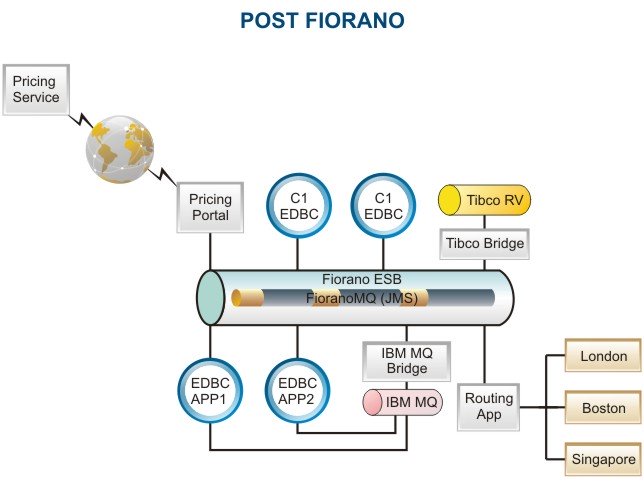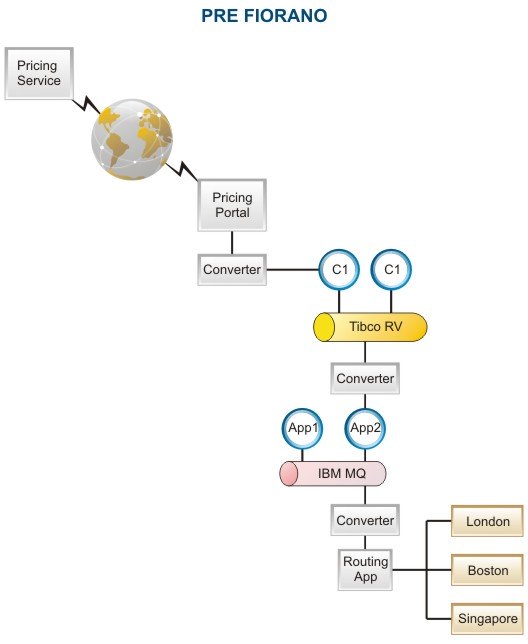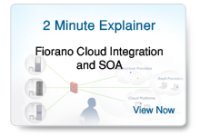Customer Profile
With headquarters in London and a network comprising of approximately 10,000 offices in 82 countries across the world, the company reviewed in this case study is one of the largest banks in the world. This institution is very committed to providing their local customers with a global banking experience.
Business Problem
The IT infrastructure had grown with the bank over time. It was built and developed on multiple technologies including multiple vendor products and applications designed using varying methodologies. Over time the bank's IT managers realized that if they were to get optimal returns from their technology investments they needed to enable the IT infrastructure to be flexible and agile enough to respond quickly and effectively to the ever growing business demands. As a result they established strict architectural disciplines vowing to overcome the followings:
- Transport-vendor Dependency
The bank infrastructure has, over time, implemented multiple transport systems, including MQSeries, Tibco and others. Seamless switching among transport vendors should be available. - Hosting Environment
There should be a reliable, high performance and 'high available' component hosting environment. - Componentization
Business logic locked within various applications should be extracted and aligned with other applications for reusability. - Well Defined Development Model
Software applications supporting the business processes were developed in an ad-hoc manner with a diverse and undefined architecture. - Black-Box Integration
Most of the time when contract programmers left the organization, the applications tend to become black boxes, making it difficult to incorporate business logic changes. - Event Driven Architecture
Provide a uniform event driven, component architecture for applications across global operations for transport independence and maximum reusability. - Reusability
No rip-n-replace approach to the existing infrastructure, choosing instead a gradual approach that allows maximum reuse of existing resources.
Solution
Our solution leverages Fiorano SOA Platform. The Fiorano SOA platform is based on Event Driven Business Component (EDBC) Architecture which is a perfect fit for the above requirements. There exists a one to one mapping between their specifications and Fiorano's EDBC architecture.
Fiorano Event Driven Business Components can be used to create process flows designed by using the Fiorano Event Process Orchestrator (Fiorano Studio) with a simple drag and drop approach. With the Event Process Orchestrator, the logical application design is mapped directly to the physical implementation, allowing the development process to become less complex and more intuitive than conventional integration suites. The end result is workflow applications that mimic the business workflows making it easier for business analysts and developers to work together in a common logical easy to understand environment.
The bank developed a miniature platform called LASER using Fiorano SOA platform directly for component development. LASER acts as a bridge on which the bank will convert all its existing applications into components using the bank APIs. The LASER platform will in turn auto-generate Fiorano components from the LASER components. More than anything LASER is one of the tools relied on to promote the event driven component architecture of Fiorano within the bank infrastructure.
The event process flow allows components to communicate with each other through messages. These messages adhere to the JMS specifications allowing components to interoperate with any standard messaging platform. The components have input ports to accept messages and output ports to send messages. The components can have more than one input and output ports allowing true event based processing. The rich set of adapters and pre-built services readily allowed integration of vendor products and black box applications. The peer to peer architecture combined with robust messaging support provided an ideal hosting environment which was stable and reliable.
Bond Trading scenarioOne such instance where the previously discussed benefits of the Fiorano solution were leveraged is within the Bond Trading scenario described below.
Prices of bonds change at a fast rate. Buyers keep track of these changes and depending on the current price may request a quote from a trading centre. Based on the availability of the Bond at the requested price, the centre can send an appropriate response to the buyer.
In this particular case, there are three financial centers located in London, Singapore and Boston. They each publish their Bonds identified by unique ISINs. The Bond details are then viewable using Graphical User Interfaces which allow users to keep track of the changing prices. The GUI also allows user to buy a bond, by specifying the quantity and asking price. Based on the ISIN, the request is then routed to the appropriate centre.
For example market data originated from data sources that publish on Tibco RV subject. Fiorano provides Tibco RV connectivity to publish and subscribe on such subjects.
Also certain applications relied on IBM MQ series for their transport. Fiorano's IBM MQSeries connectivity comes handy to talk to these applications.
The diagram below shows the bond trading process before Fiorano was introduced by the bank.

The same bond trading scenario is depicted in diagram below showing Fiorano EDBC components orchestrated in an event driven process flow. The routes are by default JMS destinations in FMQ (FioranoMQ) but any transport method can be plugged in as per the needs or preferences of the business.

Componentization of the application infrastructure in the bank based on Fiorano's component design did not happen in a big bang. Since the plan was to implement in phases, it was key to make sure that application components hosted on the new platform are still able to talk to other existing applications.
Benefits
Flexibility of Development: Business Components are easier to develop because the semantics of each independent business component is significantly simpler than the overall complexity of a single, (relatively large) monolithic application. Different Business Components can be developed by a different teams, each team can focus only on their component without having to know the details of work done by others.
- Reuse
Since each Business Component has well-defined interfaces, each component can be developed, tested and debugged independent of the other components. This not only speeds up project implementations but, in the case of well-designed business components, also leads to significantly enhanced reuse. - Dynamic Deployment and Runtime Modification/Replacement
Business components can be dynamically deployed to remote nodes at runtime, and components within a process can be easily replaced by new or updated components, further reducing the time taken to modify or change an existing process in response to business requirements. - Configuration Management and Version Control
Business components facilitate version control and dynamic configuration management, allowing fine-grained control over deployments across the enterprise.
Apart from providing a reliable messaging framework and a platform to design scalable and reusable solutions, the Fiorano SOA platform also provides several other powerful features that make business process automation simple and quick. Fiorano's platform enables configuration of uniform (reusable) error handlers across multiple process workflows. Once configured, the error handler can be plugged into any workflow by just dragging and dropping it on the flow.
In addition Fiorano provides a uniform logging mechanism across all components of every workflow deployed. The logging mechanism also works on a remote invoke thereby making flow and component status available dynamically. The key aspect of the platform is that it comes with over 60+ pre-built components and data adapters that are comprehensive enough to achieve typical implementation of business workflows with little or no coding effort.
Why Fiorano
The bank selected Fiorano after rigorous evaluation and pointed below mentioned reasons for choosing Fiorano over other competitor offerings:
- Fiorano SOA 2007 Platform's event driven component was a spot-on match to their business requirements.
- Since Fiorano's architecture is based on industry standards, the components are deployable on most ESB and application server platforms.
- Powered by FioranoMQ, the solution is very robust and scales to high throughput messaging requirements.
- Fiorano components can accept multiple inputs and provide multiple outputs.
- Fiorano Event Process Orchestrator (Fiorano Studio) is a visual tool that enables business process composition by simple drag-and-drop of components.
- Fiorano's dynamic deployment and runtime modification/replacement significantly reduces the time taken to adopt business process changes.
- Fiorano's componentized architecture standardizes application development across their global operations in addition to increasing reusability of components.
- Fiorano's peer to peer distributed architecture with central management provided easy manageability of processes.
About Fiorano Software
Fiorano Software (www.fiorano.com) is a leading provider of enterprise class business process integration and messaging infrastructure technology. Fiorano's network-centric solutions set a new paradigm in ROI, performance, interoperability and scalability. Global leaders including Fortune 500 companies such as Boeing, British Telecom, Credit Agricole Titres, Lockheed Martin, NASA, POSCO, Qwest Communications, Schlumberger and Vodafone among others have used Fiorano technology to deploy their enterprise nervous systems.
To find out more about how Fiorano can help you meet your enterprise integration objectives, visit www.fiorano.com or Email us, we will contact you!

 Japan
Japan Germany
Germany

